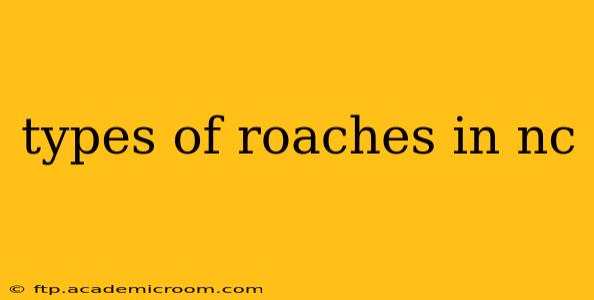Types of Roaches in North Carolina: A Comprehensive Guide
North Carolina, with its diverse climate and environments, is home to a variety of cockroach species. These pests can be a nuisance in homes and businesses, causing property damage and posing health risks. Understanding the different types of roaches found in NC is the first step in effective pest control. This guide will delve into the most common species, their identifying features, and habits, equipping you with the knowledge to effectively identify and address an infestation.
What are the most common types of roaches in NC?
Several cockroach species are prevalent throughout North Carolina. The most common include:
-
German Cockroach ( Blattella germanica): This is arguably the most widespread and troublesome cockroach species in NC, and indeed throughout the entire United States. They are relatively small (about ½ inch long), light brown, and have two dark parallel stripes running down their pronotum (the area behind their head). German cockroaches thrive in warm, moist environments, often found in kitchens, bathrooms, and near plumbing. They reproduce rapidly, making infestations difficult to control.
-
American Cockroach (Periplaneta americana): The largest common cockroach in NC, the American cockroach can reach up to 1 ½ inches in length. They are reddish-brown with a yellowish-brown border around their pronotum. These roaches prefer damp, dark areas, such as sewers, basements, and crawl spaces. While they can infest homes, they are more commonly found outdoors.
-
Brown-banded Cockroach (Supella longipalpa): Slightly smaller than German cockroaches, brown-banded roaches are about 5/8 inch long. Their distinguishing feature is the two light brown bands that cross their wings. Unlike the other species, brown-banded roaches prefer drier environments, often nesting in electrical appliances, furniture, and wall voids.
-
Oriental Cockroach (Blatta orientalis): These roaches are dark brown to black and are relatively slow-moving. They are about 1 inch long and are often found in damp, dark areas, similar to American cockroaches. They prefer cooler temperatures than the other species mentioned.
What are the signs of a cockroach infestation?
Identifying a cockroach infestation early is crucial for effective control. Look out for:
- Live roaches: Seeing roaches, especially during the day, is a clear indication of a problem.
- Droppings: Cockroach droppings look like small black pepper-like specks.
- Egg capsules (oothecae): These are small, dark brown capsules containing cockroach eggs.
- Shedding skins (exuviae): As roaches grow, they shed their exoskeletons, leaving behind empty skins.
- Unpleasant odor: Cockroaches can produce a musty, unpleasant odor, particularly in large infestations.
How do I get rid of roaches in my home?
Dealing with a cockroach infestation requires a multi-pronged approach:
- Cleanliness: Thorough cleaning is essential. Remove food crumbs, spills, and garbage regularly. Pay close attention to areas where roaches tend to hide, such as under sinks and appliances.
- Seal entry points: Caulk cracks and crevices in walls and floors to prevent roaches from entering your home.
- Store food properly: Keep food in airtight containers to prevent roaches from accessing it.
- Reduce moisture: Repair leaky pipes and fix any water damage to minimize moisture, a key attractant for roaches.
- Professional pest control: For severe infestations, professional pest control is often necessary. They have access to effective insecticides and can identify the specific species of cockroach to tailor their treatment.
How can I prevent roaches from entering my home?
Prevention is key to avoiding a cockroach infestation. Consider these preventative measures:
- Regular cleaning: Maintaining a clean home is your first line of defense.
- Proper food storage: Store all food items in airtight containers.
- Seal entry points: Identify and seal any cracks or openings in your home's exterior.
- Manage moisture: Repair leaky pipes and address any areas of excess moisture.
- Regular inspections: Regularly inspect your home for signs of cockroach activity.
This comprehensive guide should help you identify and manage cockroach infestations in your North Carolina home. Remember, early detection and proactive measures are essential for preventing widespread problems. If you suspect a serious infestation, contact a qualified pest control professional for effective and safe eradication.
